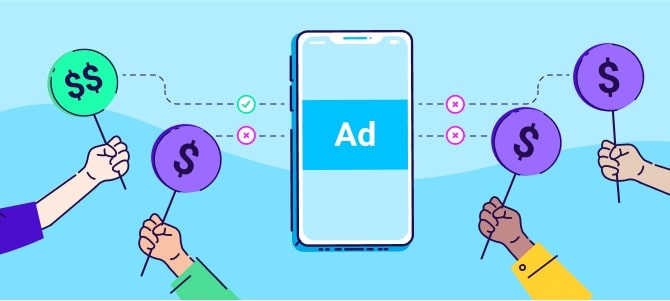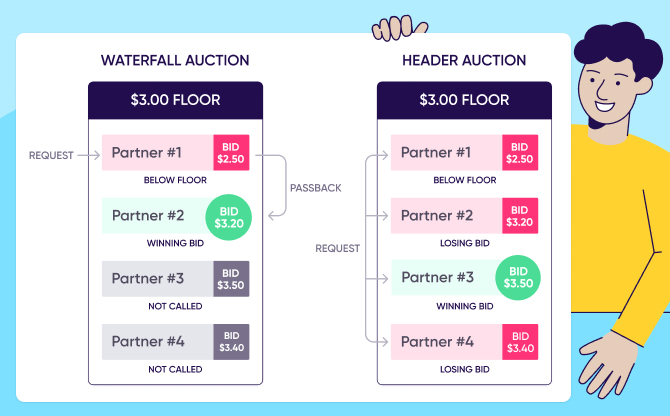
In-app bidding
In programmatic advertising, in-app bidding is a sales method that allows mobile publishers to offer their ad inventory in an auction where all advertisers can participate simultaneously in a fair competition for ad space.
What is in-app bidding?

A method of programmatic ad sales for mobile publishers in which they sell their ad inventory in a real-time auction. It’s the mobile extension of browser-driven header bidding and is sometimes referred to as in-app header bidding.
Header bidding allows advertisers to bid against one another simultaneously rather than being placed in a “waterfall” hierarchy that pre-determines the priority of bids. By allowing advertisers to compete in real-time for impressions, publishers can guarantee they’ll receive the highest price (CPMs) for their inventory.
In header bidding, the header of a publisher’s web page includes a JavaScript tag known as a “wrapper.” This tag sends requests for bids out to demand partners, including advertisers and demand-side platforms (DSPs).
Multiple advertisers bid simultaneously in an auction for the available impression. The winning bid then connects the publisher’s and advertiser’s respective ad servers to display the ad creative in that slot to the end-user. All of this happens in real-time when a user clicks on a website or an app.
In mobile apps, however, given a browser-based wrapper isn’t available, in-app bidding uses an SDK (software development kit) integration instead, which is a plugin written in the device’s native OS language (iOS or Android) to perform the same function of inviting advertisers to join the auction.
Header bidding has been around since about 2015, a lifetime in the programmatic advertising ecosystem. Mobile in-app bidding followed around 2019. But before these ad sales techniques took hold, the waterfall method was the standard, which left some significant opportunities for improvement. The next section will break down what led to the shift to header bidding and how the two methods compare.
Header bidding vs. waterfall
Header bidding was a result of advertiser’s frustration with Google’s DoubleClick for Publisher’s (DFP) ad server prioritizing their own ad exchange (AdX) ahead of other demand partners.
As a way to circumvent DFP, publishers created a hack that let them hold a real-time auction for inventory in a website’s header, accessible to demand partners outside of Google’s waterfall ranking.
The “waterfall” worked like this: Publishers set a floor price—the minimum acceptable rate for the inventory on offer. The top-ranked network attempted to broker a direct deal. If unable to do so, the opportunity was passed to the next in line of the ad network hierarchy. The deal closed whenever the floor price was met.
In the waterfall method, a publisher’s ad server calls ad networks in a predetermined, linear order. The order might be based on a manual set of prioritization rules and also on historical pricing data, meaning that the system gives preferred ranking to the ad networks who’d previously paid the best rates for an impression.
This creates a double-sided opportunity gap. For publishers, the waterfall system and its reliance on historical data caps potential revenue by limiting the possibility of gaining a higher bid from a lower-ranking ad network.

For advertisers, the system limits their access to publisher’s inventory, which in turn limits the possibility to show an end-user a more relevant ad.
Header bidding created a fair, unbiased marketplace for advertisers to compete for the purchase of a publisher’s ad inventory.
By adding a piece of code to their website’s header or an integration to their app, a publisher could send out a request to multiple demand sources, who would then be able to place simultaneous bids for the available inventory.
The waterfall method may not be entirely defunct, but header and in-app bidding have by far eclipsed its predominance in digital ad sales.
Benefits of in-app bidding
- The main benefit of header or in-app bidding is that it gives publishers the chance to achieve a higher potential revenue from ad sales—not a difficult sales pitch to attract their attention.
- Publishers, too, are keen to provide a fairer marketplace for their inventory since more diverse competition among demand partners creates greater adaptability and stability on their platforms in the long run.
- A wider array of advertisers translates into a better user experience by presenting more relevant ads among their target audiences.
- Better targeting and attribution is a big win for advertisers, too. Higher-quality placements lead to higher conversions and engagement rates.
Advertisers regularly adjust their strategies, so access to a greater number and a broader selection of platforms presents more opportunities for testing and optimizing campaigns.
- Greater visibility into the auction process is a win-win for both publishers and advertisers.
Demand partners can adjust their bids on the fly to increase their chances of winning the impression, and publishers can prioritize networks on bid value in real-time, ensuring they can secure the best price for their inventory.
Key takeaways
- Header bidding and in-app bidding have leveled what was previously an opaque, inefficient, and biased playing field.
- In the complex programmatic ecosystem, its advantages are straightforward: more advertisers can see and do exactly what it takes to win a spot with a publisher, and the highest bid always wins the impression.
- Header bidding and in-app bidding create a fair and unified auction where equal access and equal opportunity delivers net-positive results to both publishers and advertisers.



